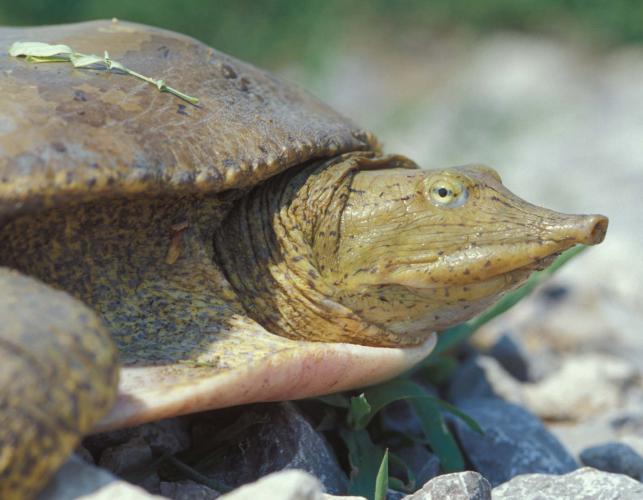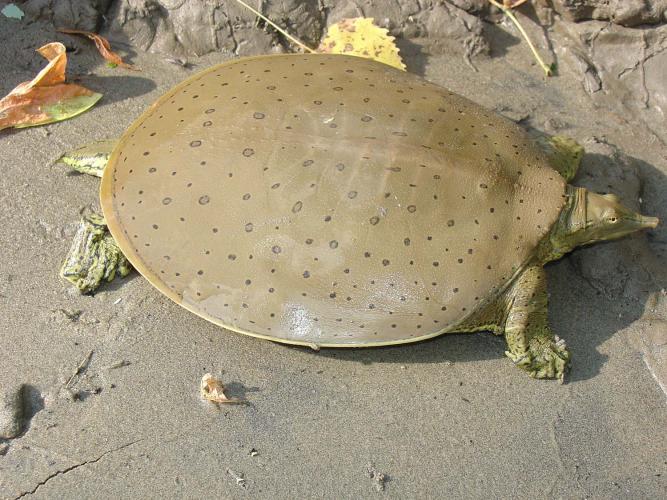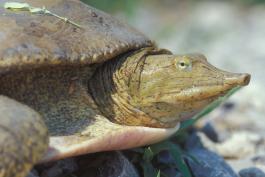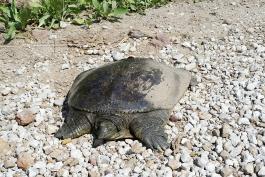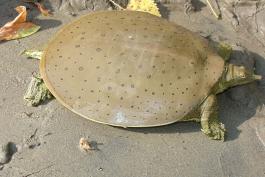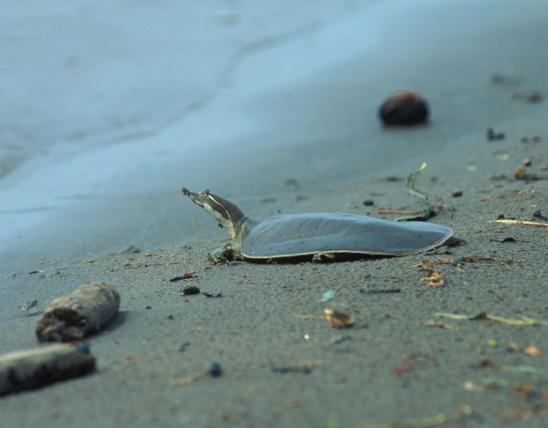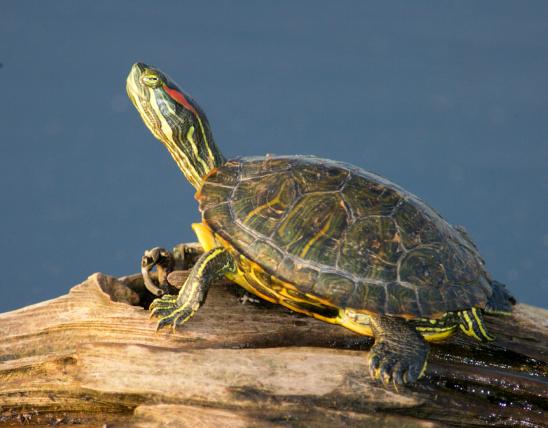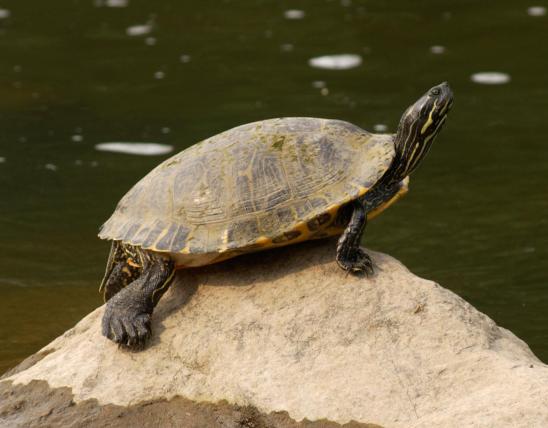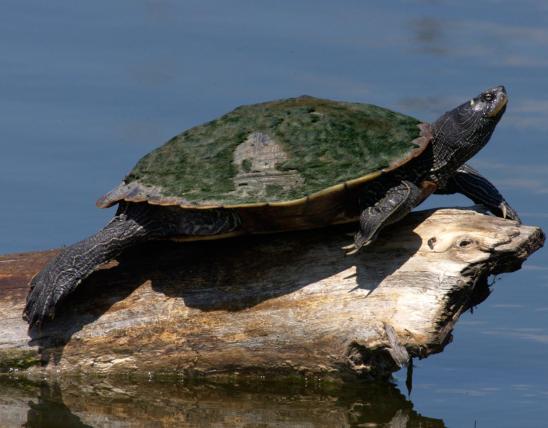
The eastern spiny softshell is a medium to large turtle with dark spots on fore- and hind limbs, a small ridge on each side of the snorkel-like snout, and small bumps or spines on the front of the carapace (top shell).
The color of the carapace varies with sex and age. Young females and males of any age have an olive or gray-tan carapace with a black line along the margin and distinct small black dots and circles. The circular markings (ocelli, or eyespots) may have a dark center. Adult females have a dark olive or tan carapace with brown and gray blotches.
Spiny softshells have a plain, cream-colored plastron (lower shell); the underlying bones can be seen through the skin.
The upper surfaces of the head, neck, and limbs are tan or olive with small brown or black markings above; the throat is grayish white with small, dark gray markings. A yellow stripe, bordered by dark brown, extends from the snout through each eye and along the sides of the head. Another light stripe runs from the angle of the jaw onto the neck.
Spiny softshells are defensive and will try to bite when captured. Though they lack a hard shell, softshells defend themselves with strong jaws and by being fast swimmers. They also use their strong, sharp claws to defend themselves when picked up. They should be handled very carefully to avoid injury.
Similar species: Missouri has two species of softshells. Both live primarily in rivers but also are known to occur in large reservoirs. Our other species, the midland smooth softshell (A. mutica mutica), lacks bumps or spines at the front of the upper shell.
Adult upper shell length: 7 to 21 inches (females); 5 to 12 inches (males).
Statewide.
Habitat and Conservation
The eastern spiny softshell mainly inhabits large rivers and streams, but it also lives in lakes, large ponds, and even roadside and irrigation ditches. It is most common in tributaries and closed side channels of the Mississippi River. This species can tolerate a variety of bottom substrates, including mud, sand, or gravel.
The eastern spiny softshell is active between late March and October. Daily activity includes foraging for food in early morning, basking in the sun on logs or along the bank, and resting in shallow water with the shell covered by mud or sand. There is a short period of feeding during the afternoon and evening that may extend into the night. Most of the night is spent sleeping buried in the bottom substrate or among tree limbs or stumps.
Spiny softshells have a habit of floating near the surface in deep water but will quickly dive to safety with the slightest disturbance.
To escape the cold temperatures of winter, this species will bury itself in 2–4 inches of mud or sand at the bottom of a river or lake starting in October or November.
Food
This species eats a variety of aquatic prey, including crayfish, insects, earthworms, snails, small mussels, fish, and tadpoles. A study of turtles on the Osage River in St. Clair County showed that they mainly ate crayfish and aquatic insects with an occasional fish. This turtle is not a threat to Missouri’s game fish populations.
Status
Spiny softshells are classified as a game species in Missouri with a season and daily limit. Recent regulation changes to reduce harvest will ensure that softshells will remain common throughout Missouri. Consult the most recent Wildlife Code of Missouri for current regulations.
At one time, two subspecies of Apalone spinifera were recognized in Missouri: the nominate subspecies, the eastern spiny softshell (Apalone s. spinifera), and the western spiny softshell (A. s. hartwegi). Molecular data showed these two subspecies are the same, and therefore A. s. hartwegi was placed into the A. s. spinifera group.
Life Cycle
This species is active from March to October. Courtship and mating occur in April and May, and eggs are laid from late May through July. The gravid female will select a sand or gravel bar, or a sandy opening, usually near water to nest, but suitable nest sites can be a considerable distance from water. The nest is a flask-shaped chamber about 4–10 inches deep. Females lay 3–39 eggs in a clutch. Larger females usually lay more eggs. There can be up to 3 clutches per season. The eggs hatch from late August to October, after incubating for 65–85 days. The shells of young turtles are about 1¼ to 1½ inches long.
Female spiny softshells become sexually mature about age 8 or 9; males become mature at about age 4. Lifespan can be at least 25 years.
Human Connections
As a game species with delicious meat, softshell turtles are economically valuable as a human food source. Indeed, members of the softshell family are eaten by people worldwide. Make sure you know the current regulations regarding their harvest.
Spiny softshells are defensive and have strong jaws. They will try to bite when captured.
Ecosystem Connections
Although softshells may prey upon nearly any species of fish, there is no evidence to show that they harm a fish population in natural waters. Like other components of our native aquatic ecosystems, they contribute to the balance of nature.
Researchers in Iowa compared the foraging habits of smooth and spiny softshells. They found that spiny softshells are less specialized in their habitat requirements than smooth softshells. Spiny softshells searched for food on the bottom, while smooth softshells located food in the water column.
To defend themselves, softshells compensate for the lack of a hard shell and scutes by having strong jaws and by being fast swimmers. Softshells also use their strong, sharp claws to defend themselves.
Members of the softshell family (Trionychidae) occur in North America, Asia, and Africa. The family has 31 species in 13 genera. Only one genus, Apalone, with three species, occurs in the United States. Softshells are well-equipped for an aquatic life. They are round and flat; their upper and lower shells are covered with skin; they lack scutes (shell scales); they have a long, tubular snout that functions like a snorkel; and there is extensive webbing on all four limbs.
